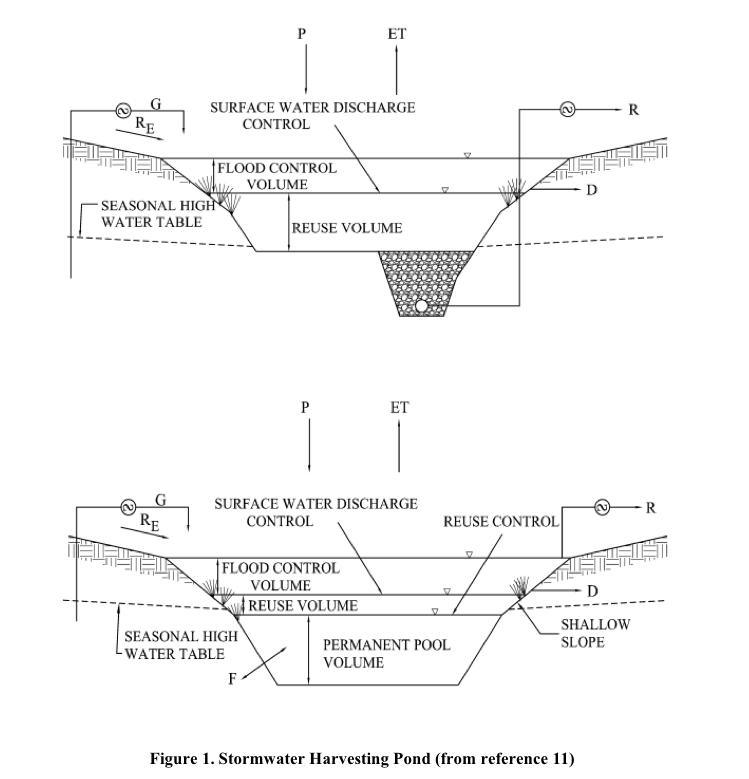STORMWATER MANAGEMENT ACADEMY
Introduction
1.1 Background
Harvesting (reuse) of stormwater is a stormwater management option. In addition, it may be an economic alternative to providing a non-potable source of water. It is also used to meet stormwater discharge pollution limits because in a wet detention pond, stormwater may not achieve sufficient removal of some pollutants before discharge. However, if a volume of stormwater can be removed by harvesting the stored water before discharge, the cumulative amount of pollutants in the discharge will be reduced. This can be accomplished using stormwater harvesting (reuse) ponds.
The use of Biosorption Active Media (BAM), a soil amendment, is also helpful in the reduction of pollutants as the water passes through the media. The concentrations of pollutants are reduced before surface water discharge or deep percolation. This can be accomplished using retention or biodetention areas. After retention or biodetention, water can be stored for harvesting.
Nutrient loadings, especially nitrogen and phosphorus, in stormwater runoff are a major concern in Florida, and loading reductions are found in research areas where regulations continue to evolve. Stormwater runoff from highways is a source of pollution to surface water bodies and groundwater; thus, the results of this project developed options for treatment/harvesting systems that reduce nutrient and concurrent pollutant loadings from highway runoff.
Stormwater runoff from highways and other impervious surfaces often has levels of nitrogen and phosphorus not acceptable to receiving surface or ground waters (1). Nitrate, a species of nitrogen, can have harmful health effects when ingested. Nitrogen and phosphorus species concentrations are also of importance in watersheds because they are limiting nutrients for plant and algal growth in aquatic systems. Excess nitrogen and phosphorus in surface waters causes eutrophication, which can eliminate the beneficial use of the water body.
Nitrate contamination of groundwater is of concern due to the large number of private drinking water wells that are not monitored or treated. Nitrate is listed by the U.S. EPA as a primary drinking water standard with a maximum contaminant level (MCL) and maximum contaminant level goal (MCLG) of 10 mg/L as nitrogen (2). Lower concentration limits for Nitrate are set to minimize environmental impacts to surface and groundwater.
Typically, the primary limiting nutrient for plant and algal growth in freshwater systems is phosphorus, and in marine ecosystems it is nitrogen (4). An excess of limiting nutrients is a major factor in eutrophication. Eutrophication is defined by the United States Environmental Protection Agency (U.S. EPA) as the increase and accumulation of primary producer biomass in a water body through time (5). According to the National Oceanic and Atmospheric Administration (NOAA), the most common single factor causing eutrophication is an increase in the concentrations of nitrogen and phosphorus species (6). Several different algal species (7) have stimulated growth when there are sufficient nutrients available to them. The increase in the number and types of algal species in water also has additional effects on the use of the water which contains the algal populations. In some situations, the water becomes unusable for specific purposes, such as a source of drinking water and for recreational uses. (8).
Oxygen depletion is also noted when there is nutrient excess. Excess inorganic nitrogen loads, either due to stormwater influent or algal die off, increase nitrifying bacteria and as a result, a significant amount of oxygen is consumed.
The practical implementation for stormwater treatment is governed by regulations requiring either a fixed removal percentage or net improvement of the receiving water body which implies a reduction of a target water quality parameter. The target parameter in many areas is a nutrient species. The removal of nutrients is also one of the more common targets for Total Maximum Daily Load (TMDL) reduction.
1.2 Objectives
The purpose of this work is to develop additional filtration options for the treatment of nitrogen and phosphorus found in stormwater. In addition, the options must address field operating conditions. The expectation is to provide these options consistent with current rules and regulations regarding stormwater treatment.
Specific Statements of Objectives are:
1. Develop filtration media mixes that remove nutrients from the water in stormwater wet detention ponds.
2. Deploy at least two of the mixes in a full scale operation to demonstrate successes and problems of operation.
3. Address the concern of effects on adjacent ground water when harvesting from a wet detention pond.
1.3 Limitations
The testing was done for harvesting systems in the state of Florida, thus the climate conditions of the State have an effect on the results. Since the testing was completed using UCF’s Bold & GoldTM Biosorption Activated Media (BAM), the results may not translate to other BAM products. The pollutants of interest were limited to solids, turbidity, nitrogen, and phosphorus.
Read full report(PDF) here: Stormwater Harvesting Using Retention and In-Line Pipes for Treatment
About The Stormwater Management Academy
www.stormwater.ucf.edu
“Mission: Providing educational materials and research to advance an understanding and practice of stormwater management and to influence policy and procedures.”
Tags: in-line pipes, retention, stormwater harvesting, stormwater treatment, Water Treatment







 RSS Feed
RSS Feed